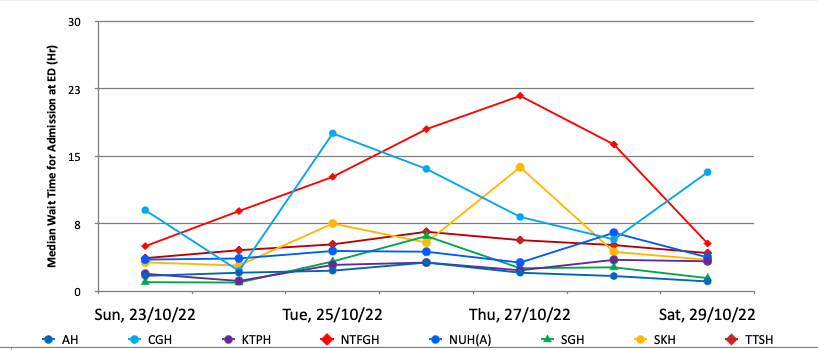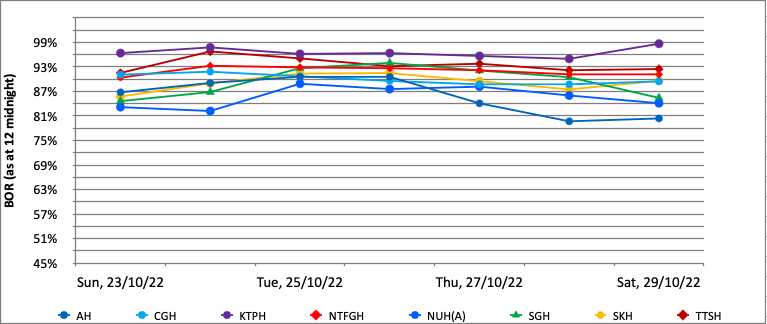Hospitals will no longer set aside whole wards for COVID-19 patients: Ong Ye Kung
The Health Minister was responding to questions from several Members of Parliament (MP) about measures to alleviate the ongoing crunch in hospital beds.
SINGAPORE: Hospitals will no longer set aside whole wards to cohort COVID-19 patients, said Health Minister Ong Ye Kung on Tuesday (Nov 8).
In the earlier stages of the pandemic, hospitals had ringfenced beds for COVID-19 patients to reduce the probability of infecting other patients.
Noting high vaccination rates and good levels of immunity against severe illness within the population, he said hospitals should be allowed to triage or assess their patients based on clinical severity and priority for treatment, and not manage COVID-19 patients to a different standard.
"Our approach to live with COVID-19 needs to be extended to hospital operations as well and it is time for us adopt a more flexible and balanced approach to hospital bed assignment," he said.
Speaking in Parliament, Mr Ong said hospitals will continue their current practice of using isolation beds for patients with infectious diseases, including COVID-19, if clinically assessed to have higher propensity of infection spread.
"This flexibility is important to our hospitals to help them optimise the use of beds. In a crunch situation, it makes all the difference," he said.
He pointed to how the recent XBB wave had exacerbated the bed crunch situation in hospitals with about 800 beds set aside for COVID-19 patients.
"About 80 per cent were occupied, which meant we still had about 160 beds unoccupied for contingency purposes. Although this is not a big number, it nevertheless constrains hospital operations and impede the clearing of patients waiting for beds at the EDs," he said.
"Whether due to demand or supply factors, we need to recognise that we run a very high throughput hospital system. In such a system, even a small mismatch in demand and supply of a couple hundred beds will cause waiting times to spike up significantly," he added.
Mr Ong was responding to questions from several Members of Parliament (MP) about measures to alleviate the ongoing crunch in hospital beds.
CNA had earlier reported that the waiting time for admission had surged to as high as 50 hours at some hospitals last month due to high numbers of patients at public emergency departments (EDs) across the country.
Latest data available from Ministry of Health (MOH) showed that the median waiting time for admission to wards from emergency departments was between one hour and 21.7 hours for the week of Oct 23.

Among hospitals tracked by the MOH, latest figures show that daily bed occupancy rates ranged from 79.7 per cent to 98.7 per cent between Oct 23 and Oct 29.

To further alleviate the crowdedness at the EDs in the short term, Mr Ong said Singapore will activate more Transitional Care Facilities (TCFs). As step-down care facilities, TCFs can help to free up acute beds in hospitals as they admit medically stable patients from the public hospitals while they wait for their transfers to intermediate, long-term care facilities, or for their discharge plans to be finalised.
Currently, there are three TCFs which are operated by private providers at wards in Sengkang Community Hospital, Expo Hall 10 and Crawfurd Hospital. Together, they have a capacity of about 400 beds, said Mr Ong.
He said that there needs to be a "firm handshake" between each TCF and a public hospital so that the privately operated TCF will gain confidence in admitting patients transferred by a public hospital, with the assurance that should it need any clinical help, the public hospital will step in.
"Without this understanding, TCF will naturally be conservative in admitting patients and there will be little movement of the stable patients," he said.
Citing Sengkang Community Hospital TCF - which has a solid partnership with Sengkang General Hospital - as an example, Mr Ong said more hospitals will be paired up with TCFs.
They include Changi General Hospital which will be paired with EXPO Hall 10 run by Raffles Medical Group as well as Tan Tock Seng Hospital, which will be paired with Crawfurd Hospital.
Mr Ong added that MOH is actively working on new TCFs in the north and west, to partner Khoo Teck Puat Hospital and Ng Teng Fong General Hospital respectively.
MATCHING DEMAND AND SUPPLY OF BEDS
During his speech, Mr Ong cited mismatches in demand and supply of hospital beds as reasons for the current bed crunch.
Despite a 16 per cent reduction in average monthly ED attendances this year compared to 2019, the proportion of patients with more severe conditions and require more attention rose from 8 to 11 per cent over the same period.
This works out to an increase of a few hundred patients every month and adds to the workload of EDs, he said.
He added that the demand has also been more volatile, with "many more" patients going to the EDs during an infection wave.
On the supply side, the country's ageing population has resulted in a lower turnover of hospital beds with more patients staying longer in the hospital.
According to Mr Ong, the percentage of patients who stay longer than 21 days has more than doubled from 1.6 per cent of all hospitalised patients in 2019 to 3.8 per cent in 2022.
In addition, the pandemic also caused delays to the opening of several nursing homes and community day care facilities as well as Woodlands Health Campus and the Integrated Care Hub at Tan Tock Seng Hospital, which were originally slated to open this year.
Had Woodlands Health Campus and the Integrated Care Hub opened, Mr Ong said they would have added at least several hundred more beds during the pandemic.
The two healthcare facilities are expected to open progressively from the end of next year, and together with the expanded Singapore General Hospital Medical Campus, they can add about 1,900 more public hospital beds, he said.
Noting that non-urgent cases still make up about 40 per cent of ED attendances, Mr Ong urged the public to only go to the EDs for emergency conditions, and visit a GP clinic or family doctor if their condition is mild or non-critical. He also encouraged the public to keep their COVID-19 vaccinations up to date in order to prevent severe illness.
"If we can all do our part, we will help healthcare workers earn back their normalcy of life, as they did for us and the rest of society," he said.

















